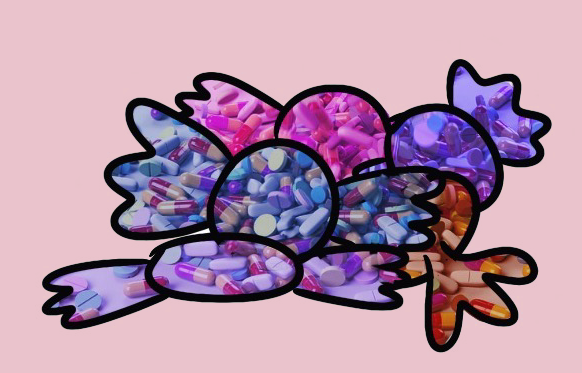In the face of fentanyl
Understanding the fentanyl crisis in Santa Clara County

The Drug Enforcement Administration released a public warning about the rise in seizures of colorful fentanyl pills, dubbed “rainbow fentanyl,” on Aug. 30.
December 22, 2022
Fentanyl is 50 times stronger than heroin and 100 times stronger than morphine — even a two-milligram dose, the equivalent of 10 to 15 grains of salt, could be fatal. According to U.S. Drug Enforcement Administrator Annie Milgram, it’s the “single deadliest drug threat our nation has ever encountered” and the leading cause of death and of nationwide surges in drug overdoses that claimed 107,375 lives in 2021.
Fentanyl is an addictive opioid legally used as an anesthetic in medical procedures where it is administered in small doses and under close medical supervision. Pharmaceutical fentanyl is primarily used for pain relief, but also induces relaxation and euphoria. Since illicitly manufactured fentanyl is cheap, it’s often used as an additive to less potent drugs and prescription pills, making it one of the most prolific contributors to drug overdoses.
In 2021, Santa Clara County received reports of over 130 opioid-related deaths, continuing a steep upwards trend since 2018 when there were 11 reported casualties. Director of Addiction Medicine Services Mira Parwiz notes that youth are especially vulnerable to fentanyl addiction, not only because of fentanyl laced drugs, but also from the influence of social media on distribution.
“We often hear kids have opted to get Xanax or oxycodone, to buy it off the street, buy it from somebody from social media, [or] buy it from a friend,” Parwiz said. “What [often happens is that] these fake pills are laced with fentanyl. We have had many, many kids who have lost their [lives] because they thought they were just taking a Xanax pill and they did not know what was inside of it. Selling it on social media has played a huge role in it.”
Although SCC has a dedicated investigation unit for local fentanyl-related cases, Parwiz also founded the Santa Clara County Opioid Overdose Prevention Project as part of an initiative to spread awareness about fentanyl lacing and opioid safety.
“[Our goal is for there to be] great outreach [in] every part of the community, [especially] among our youth, so we have a safer community for everybody,” Parwiz said. “When you lose a friend [it affects] you, [your] family and the entire community. So that’s my hope, that we can provide education and prevention methods and treatment options for those who are struggling.”
Since 2016, SCCOOPP has distributed naloxone, a lifesaving antidote that reverses fentanyl overdoses, to all high schools and middle schools in the county. The organization has also opened several clinics geared at providing naloxone kits and education and coordinated multiple social media campaigns to raise fentanyl awareness. According to Parwiz, SCCOOPP’s next steps include “[building] a better partnership with schools to provide opioid prevention education to middle school and high school students.”
“We’re really hoping to be involved on the ground [with] student leader [bodies] in high schools and [to] promote within youth organizations about safety precautions, about not using drugs and especially street drugs that have fentanyl,” Parwiz said.
The Alcohol and Drug Foundation (ADF) claims that educating children about drug use at a young age enables students to acquire necessary skills on safety, while also providing students with background knowledge on the side effects of drugs and helping them understand the underlying health concerns. The addition of drug education in school curriculum would raise awareness of the impact of substance abuse on communities, and utilizes the new approach of teaching children the effects of substance abuse, rather than simply saying not to use drugs.
Senior Arnav Kumar believes safe drug use education should be implemented in schools to reduce the issue of people accidentally taking fentanyl-laced substances. According to Kumar, educating students would cause significant change and help alleviate the issue of substance abuse among youth.
“If you’re going to be realistic, [drug use is] going to happen either way,” Kumar said. “I think that safe drug education should be taught the same way we [learned] sex education. Just saying don’t do it [has] never worked in the past. You [need] to teach the actual legitimate dangers, not just bulls—.”
Laura Didier has a similar viewpoint about the implementation of drug education. Didier is the outreach coordinator for Song for Charlie, a non-profit organization working towards spreading awareness about fake pills containing fentanyl. She joined the organization after losing her 17-year-old son to counterfeit pills. She and many other volunteers go from school to school, giving presentations to spread awareness about the effects of substance abuse and the deception used in selling drugs.
“Many young people don’t understand that they’re getting a counterfeit pill, [as] this generation of young people [has] grown up with pills,” Didier said. “There’s always some kind of a pill you can take and unfortunately, the drug [dealers] of these evil drugs, [understand that] this [is a] market for making counterfeit pills and selling them deceptively as something else.”
Rainbow fentanyl pills are colorful fentanyl pills disguised to represent candy. This disguise is used in order to attract and encourage addiction among children and teens. On Oct. 17, a public safety alert was sent out in Sacramento California to make citizens aware of the rising counterfeit drug crisis. In 2021, the California Department of Public Health declared that 5,722 deaths out of 6,843 opioid related deaths were caused by fentanyl. Aware of the crisis, Didier has recently been working with local officials as well as different community agencies in order to create public awareness campaigns.
“We want to just bombard kids with information [about] what’s going on out there, to [know] what to look out for [and understand] how to keep themselves safe [and] how to help a friend,” Didier said. “[And] as a mom [I believe that] we need to talk about different types of laws or different types of programs that need to be put into place [in order to] help turn this crisis around.”
Even a small amount of fentanyl can have a substantial impact on one’s health, let alone the large doses that are laced into pills and given to children. According to Dider, being aware of the growing drug epidemic allows for people to become more conscious of what is happening, making them cautious about what they are consuming.
“We need really effective intervention and treatment for young people who are struggling with substance [abuse],” Didier said. “I just hope to see the numbers turn around but right now, [it is] too soon to tell how many more years till [we] hopefully start seeing declines of [the] number [of casualties caused by substance abuse]. Unfortunately, these deadly synthetic drugs aren’t aren’t going anywhere, which is why] I’m so passionate about [spreading] awareness and education, so that people really understand what’s happening.”



















